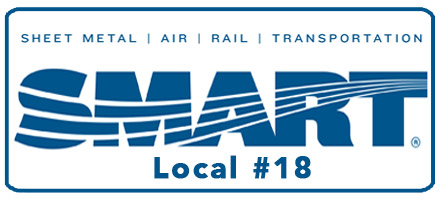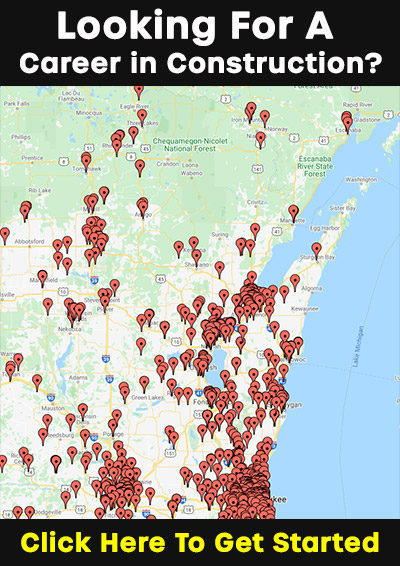Sheet Metal Workers International Association
SHEET METAL WORKERS
Work Description
Sheet metal workers layout, shear, form, fabricate, weld, solder, assemble and service heating and cooling systems, and exterior building ornamentation. They fabricate, manufacture, and install commercial, industrial and residential appliances and products.
Working Conditions
Combination of shop work and construction site work. Use shop fabrication machinery; outdoor work may require working from ladders and scaffolding.
Qualifications
- High school diploma or GED
- 18 years old or high school graduate at age 17
- Physically capable of performing the trade
- Good physical condition
- Recommended high school courses: general math, shop math, algebra, geometry, mechanical and architectural drawing, general science, shop courses, computers.
Application Process
- Apply to Joint Apprenticeship Committee
- Submit high school transcript or GED
- Pass an aptitude test
- Interview with Joint Apprenticeship Committee
- Apprentices selected by employers from a list ranked according to test/interview scores
Terms of Apprenticeship
- 5 years/10,000 hours of on-the-job training
- 504 hours of related classroom instruction (paid)
- 330 hours of night school on own time to include first aid course
- First year is probationary period
- Wage scale systematically increases throughout the apprenticeship on a percentage basis
For More Information:
Sheet Metal Workers Local #18
2201 Springdale Road, Waukesha, WI 53186
Phone: 262-798-1818 Fax: 262-798-1837 Toll Free: 800-242-5822
Website: http://www.smwlu18.org/
Scott Knocke, President/Business Manager
Email: sknocke@smwlu18.org
Brad Kalcic, Financial Secretary-Treasurer
Email: bkalcic@smwlu18.org
Craig Wagner, Business Representative
Phone: 715-498-1926
Email: cwagner@smwlu18.org
Matthew Van Der Puy, Business Representative
Training Coordinator
Phone: 920-889-0638
Email: mvanderpuy@smwlu18.org
Dan Wippich, Business Representative
Phone: 920-819-7300
Email: dwippich@smwlu18.org
Craig Holzem, Statewide Organizer
Phone: 715-498-1615
Email: cholzem@smwlu18.org
Hallie Jennerman, Statewide Organizer
Phone: 262-875-1635
Email: hjennerman@smwlu18.org
Apprenticeship Info
Mark Anderson, Training Coordinator
Phone: 715-289-3116
Email: ELW.Training.Center@gmail.com
Scott Tlachac, Training Coordinator
Phone: 920-215-6278
Email: foxvalleyjatc@smart18.org
Website: http://www.fvasmapprenticeship.org/
Information for Counties: Forest, Florence, Marinette, Oconto, Menominee, Shawano, Door, Brown, Waupaca, Outagamie, Kewaunee, Waushara, Winnebago, Marquette, Green Lake
Scott Knocke, President/Business Manager
Email: sknocke@smwlu18.org
Dan Wippich, Business Representative
Phone: 920-819-7300
E-mail: dwippich@smwlu18.org
Craig Holzem, Statewide Organizer
Phone: 715-498-1615
Email: cholzem@smwlu18.org
Hallie Jennerman, Statewide Organizer
Phone: 262-875-1635
Email: hjennerman@smwlu18.org
Scott Tlachac, Training Coordinator
Phone: 920-215-6278
Email: foxvalleyjatc@smart18.org
Information for Counties: Calumet, Manitowoc, Fond du Lac, Sheboygan as follows:
Scott Knocke
President/Business Manager
Email: sknocke@smwlu18.org
Matthew Van Der Puy, Business Representative
Training Coordinator
Phone: 920-889-0638
Email: mvanderpuy@smwlu18.org
Craig Holzem, Statewide Organizer
Phone: 715-498-1615
Email: cholzem@smwlu18.org
Hallie Jennerman, Statewide Organizer
Phone: 262-875-1635
Email: hjennerman@smwlu18.org
Information for Counties: Vilas, Oneida, Lincoln, Langlade, Marathon, Wood, Portage, Price, Taylor, Clark as follows:
Scott Knocke, President/Business Manager
Email: sknocke@smwlu18.org
Craig Wagner, Business Representative
Phone: 715-498-1926
Email: cwagner@smwlu18.org
Craig Holzem, Statewide Organizer
Phone: 715-498-1615
Email: cholzem@smwlu18.org
Hallie Jennerman, Statewide Organizer
Phone: 262-875-1635
Email: hjennerman@smwlu18.org
Mark Anderson, Training Coordinator
Phone: 715-289-3116
Email: ELW.Training.Center@gmail.com
Sheet Metal Workers International Association (SMWIA)
 The International Headquarters building for the Sheet Metal Workers International Association is open from 8:30am to 5:00pm Monday through Friday. Most of our departmental offices are located at our headquarters at:
The International Headquarters building for the Sheet Metal Workers International Association is open from 8:30am to 5:00pm Monday through Friday. Most of our departmental offices are located at our headquarters at:
Sheet Metal Workers International Association
1750 New York Avenue, NW - 6th floor
Washington, DC 20006
Website: http://www.smwia.org
History
The abridged version of this history, which will be published throughout the year in this and the next five issues of the Journal, begins with a look backward to the very beginning of the SMWIA, then picks up the story in the 1980s.
From there, it follows the union’s efforts to confront the challenge of nonunion construction, protect and raise living standards for its various membership groups, and anticipate and even help create new work opportunities for skilled sheet metal workers. If it does not tell a story of continuous “progress and achievement,” as many union histories tend to do, it does attempt to give a frank appraisal of the leadership’s vision, policies, and goals and how these changed over time; the memberships’ willingness to
buy into IA programs designed to grow market share; and the effectiveness of joint labor-management ventures to keep up with changes in technology, in the composition of the work force and the structure of the industry, and in the perceived value of a union-trained work force. In the process, it addresses issues that are as old as the
SMWIA itself: the tension between local autonomy: and IA authority, the failure to organize outside of city centers, the competing interests of building trades and production workers, the rise and fall of different branches of the trade, and the difficulty of sustaining an international organization through times of economic depression, corporate and political hostility, and internal conflict.
Because this history follows three different IA administrations over the last thirty years, it is, in a sense, a study in leadership: It pits visions of what the union could and should be against the everyday realities of internal politics, practical economics, and competing interests. It examines the difficulty of implementing change—even when the stakes are high—in an organization that values tradition and local autonomy. And it weighs the benefits of satisfying short-term demands against the costs of ignoring the future, a risky calculation for any sitting president but one that cannot be ignored for long if the union intends to survive.





